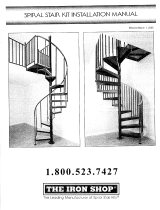The Arke K03018 is a versatile and customizable staircase system that offers a stylish and modern solution for connecting different levels in your home. With its sturdy construction and easy-to-follow assembly instructions, the Arke K03018 is suitable for both DIY enthusiasts and professional installers. The system includes a variety of components that allow you to create a staircase that perfectly fits your space and requirements, including adjustable treads, balusters, handrails, and a landing platform.
The Arke K03018 is a versatile and customizable staircase system that offers a stylish and modern solution for connecting different levels in your home. With its sturdy construction and easy-to-follow assembly instructions, the Arke K03018 is suitable for both DIY enthusiasts and professional installers. The system includes a variety of components that allow you to create a staircase that perfectly fits your space and requirements, including adjustable treads, balusters, handrails, and a landing platform.






-
 1
1
-
 2
2
-
 3
3
-
 4
4
-
 5
5
-
 6
6
-
 7
7
-
 8
8
-
 9
9
-
 10
10
-
 11
11
-
 12
12
-
 13
13
-
 14
14
-
 15
15
-
 16
16
-
 17
17
-
 18
18
-
 19
19
-
 20
20
-
 21
21
Arke K03018 Installation guide
- Type
- Installation guide
The Arke K03018 is a versatile and customizable staircase system that offers a stylish and modern solution for connecting different levels in your home. With its sturdy construction and easy-to-follow assembly instructions, the Arke K03018 is suitable for both DIY enthusiasts and professional installers. The system includes a variety of components that allow you to create a staircase that perfectly fits your space and requirements, including adjustable treads, balusters, handrails, and a landing platform.
Ask a question and I''ll find the answer in the document
Finding information in a document is now easier with AI
in other languages
- español: Arke K03018 Guía de instalación
Related papers
-
Arke K03041 Installation guide
-
Arke K21011 Installation guide
-
 Fontanot K03030 Installation guide
Fontanot K03030 Installation guide
-
Arke K03030 Installation guide
-
Arke K03030 Installation guide
-
Arke K21003 Installation guide
-
Arke K07088 Installation guide
-
Arke K05003 Installation guide
-
Arke K03071 Installation guide
-
Arke K03030 Dimensions Guide
Other documents
-
WM Coffman 802428 Installation guide
-
Targus APTB02 Datasheet
-
Everbilt 20334 Operating instructions
-
Targus APTB03 Datasheet
-
 The Iron Shop EB5613 Installation guide
The Iron Shop EB5613 Installation guide
-
Mylen STAIRS EC60P12V012 Installation guide
-
Mylen STAIRS EC60Z14A001 Installation guide
-
Mylen STAIRS EP42B14B101 Installation guide
-
 Colonial Elegance K5015-36-P06 Installation guide
Colonial Elegance K5015-36-P06 Installation guide
-
 BLOTZ B08-FG-004 Assembly Instructions
BLOTZ B08-FG-004 Assembly Instructions
























